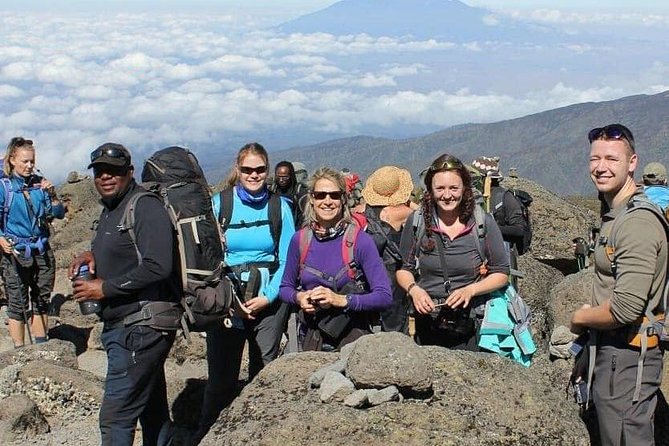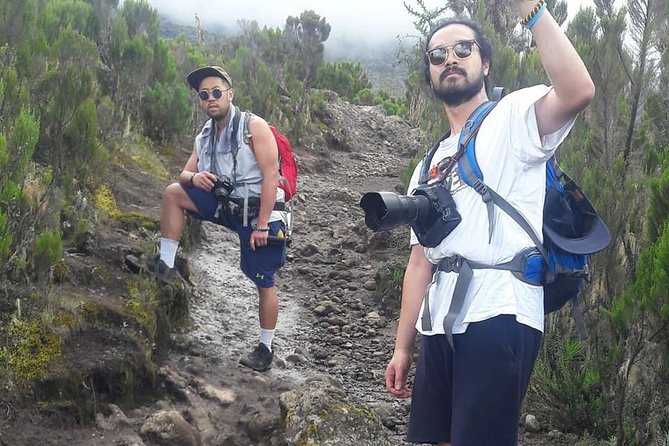Climbing Kilimanjaro via the Marangu Route is a renowned adventure that captivates both novice and experienced trekkers. This 6-day journey offers a gradual ascent through lush rainforests and alpine deserts, culminating in a chance to stand atop the highest peak in Africa. With proper preparation and acclimatization, climbers can maximize their chances of reaching the Uhuru Peak and witness breathtaking views. While the all-inclusive package ensures essential gear and meals, there are crucial health and safety considerations that should be carefully navigated to make the most of this once-in-a-lifetime experience.
Key Points

- The Marangu Route, also known as the "Coca-Cola" or "Tourist" route, is considered the easiest for first-time climbers due to its gradual ascent and comfortable mountain huts.
- Thorough preparation for fitness and gear, including breaking in hiking boots and packing warm layers, is essential for a successful Kilimanjaro climb via the Marangu Route.
- Proper acclimatization, with multiple nights at key elevations, is crucial for high-altitude climbing and increases the chances of safely reaching the Uhuru Peak.
- The 6-day Marangu Route covers approximately 37 miles with an elevation gain of nearly 13,000 feet, starting from Moshi and passing through lush rainforest, moorland, and alpine desert landscapes.
- Health and safety considerations are important, as the trek requires strong physical fitness and is not recommended for those with certain medical conditions or serious back problems.
About the Marangu Route

The Marangu Route, also known as the "Coca-Cola" or "Tourist" route, is one of the most popular and well-established paths to the summit of Mount Kilimanjaro.
This route is favored for its gradual ascent, comfortable mountain huts, and availability of porters to carry gear. It’s considered the easiest of Kilimanjaro’s routes, making it a good choice for first-time climbers.
However, the Marangu Route also has a lower summit success rate compared to other routes due to its rapid ascent. Trekkers must be prepared for the physical demands of the climb, as the route covers approximately 37 miles with an elevation gain of nearly 13,000 feet.
You can also read our reviews of more tours and experiences in Moshi.
Preparing for the Climb
Climbing Kilimanjaro via the Marangu Route requires thorough preparation. Hikers must ensure they’ve the necessary fitness and gear. This includes breaking in hiking boots, packing warm layers, and carrying a daypack with essentials like water, snacks, and first aid.
It’s crucial to acclimate to the altitude gradually, so hikers should consider arriving a few days early. Staying hydrated and avoiding alcohol are also key.
Travellers should pack medications for altitude sickness, along with any personal prescriptions. Porters will carry the main luggage, but hikers must still be able to manage their own daypack on the trail.
With proper planning, the Marangu Route can be an exhilarating and rewarding experience.
Gear and Equipment

Proper gear and equipment are essential for a successful Kilimanjaro expedition via the Marangu Route. Climbers should pack warm, layered clothing, including thermal underwear, fleece jackets, and waterproof outerwear. Sturdy, broken-in hiking boots with good traction are a must.
Trekking poles can help maintain balance and reduce strain on the knees. Other important items include a warm sleeping bag, headlamp, sunglasses, and sun protection.
The tour includes 3-season mountain tents and double-layered sleeping mats, but climbers should bring their own personal items. Renting or purchasing the right gear beforehand ensures a comfortable and safe climb to the summit of Africa’s highest peak.
Day-by-Day Itinerary
This 6-day Kilimanjaro climb via the Marangu Route begins with an early departure from Moshi to the Marangu Gate, the starting point of the hike.
From there, the trail winds through lush rainforest, with various viewpoints and rest stops along the way.
On Day 2, the group reaches Horombo Hut, where they’ll spend the night.
The next few days involve a gradual ascent, passing through moorland and alpine desert landscapes.
On Day 5, the final push to the summit takes place, with an early morning start for the summit attempt.
After the descent, the tour concludes with a transfer back to Moshi.
Altitude Acclimatization
Typically, proper acclimatization is crucial when climbing Kilimanjaro. The gradual ascent allows your body to adjust to the decreasing oxygen levels at higher altitudes.
This Marangu route takes you up slowly, giving your body time to adapt. You’ll spend multiple nights at key elevations, like Mandara Hut and Horombo Hut, to help your body acclimate.
Though altitude sickness can’t be predicted, this gradual approach maximizes your chances of reaching the summit safely. Staying hydrated, eating well, and taking it slow are also important.
With proper acclimatization, you’ll be better prepared to handle the thin air and strenuous hike to Uhuru Peak.
Health and Safety Considerations
Climbing Kilimanjaro requires a strong level of physical fitness. The trek isn’t recommended for travelers with back problems or serious medical conditions, as the high altitude and strenuous nature of the climb can be challenging.
Infants must sit on laps, and infant seats are available. The tour isn’t wheelchair accessible, but it’s located near public transportation. Climbers should be prepared for the physical demands of the trek and consult with a doctor before booking.
The tour operator ensures fair wages for the mountain crew, which are approved by the Kilimanjaro National Park Authority, promoting ethical practices.
Booking and Cancellation Policy
The tour is a private activity, with only your group participating.
Confirmation is received at the time of booking. You can enjoy free cancellation up to 24 hours before the experience starts.
The price starts from $1,800.00 per person, with the lowest price guarantee.
The tour includes:
- WiFi on board
- All fees and taxes (18% VAT on tour fees & services)
- Meals: 5 Breakfasts, 5 Lunches, 5 Dinners
- 3 Season mountain tents and double-layered sleeping mats
- Fair wages for the mountain crew, approved by the Kilimanjaro National Park Authority
Frequently Asked Questions
Can I Bring My Own Food and Snacks on the Climb?
You can bring your own food and snacks on the climb. The tour includes all meals, but you’re welcome to supplement with your own provisions if desired. Be mindful of weight and space constraints in your pack.
How Many People Typically Join This Group Tour?
The group size for this private tour is limited to just your group. As it’s a private activity, only the participants in your group will be part of the experience.
What Is the Average Age Range of Participants?
The typical age range of participants varies, though the tour attracts adventurous travelers of all ages. Most climbers tend to be between 30 and 60 years old, though younger and older adventurers have also joined the excursion.
Can I Rent Equipment From the Tour Company?
Yes, the tour company offers equipment rental. Hikers can rent gear like trekking poles, sleeping bags, and mountain boots to use during the climb. Renting equipment is a convenient option for travelers who don’t want to bring their own.
Do I Need to Obtain a Visa to Climb Kilimanjaro?
Yes, climbers need a visa to enter Tanzania and climb Kilimanjaro. Visitors can obtain a tourist visa online or upon arrival at the airport. It’s recommended to check current visa requirements before booking the trip.
The Sum Up
Climbing Kilimanjaro via the Marangu Route is an incredible adventure that offers a scenic and gradual ascent to the summit. With proper preparation and acclimatization, trekkers can enjoy breathtaking views and maximize their chances of reaching Uhuru Peak. The all-inclusive package ensures a memorable experience on Africa’s highest mountain.
More 6-Day Experiences in Moshi
More Tour Reviews in Moshi
Not for you? Here's more nearby things to do in Moshi we have reviewed
- Day Trip To Tarangire National Park
- Mountain Kilimanjaro Climbing 6 Days Machame Route
- 6 Days Rongai Route Climbing Mt.Kilimanjaro
- 7-Day Kilimanjaro Climb Machame Route
- 7-Days Tour Mount Kilimanjaro Trekking via Machame Route
- Kilimanjaro: Lemosho Route and Camping Safari
- 8 Days 7 Nights Private Lodge Safari
- 5 Days Comfort Safari in Tanzania
- 2 Days Lodge Safari.
- One Day Tanzania Safari – Tarangire or Arusha National Park
- Day Trip Lake Manyara
- Mt.kilimanjaro-machame Route
